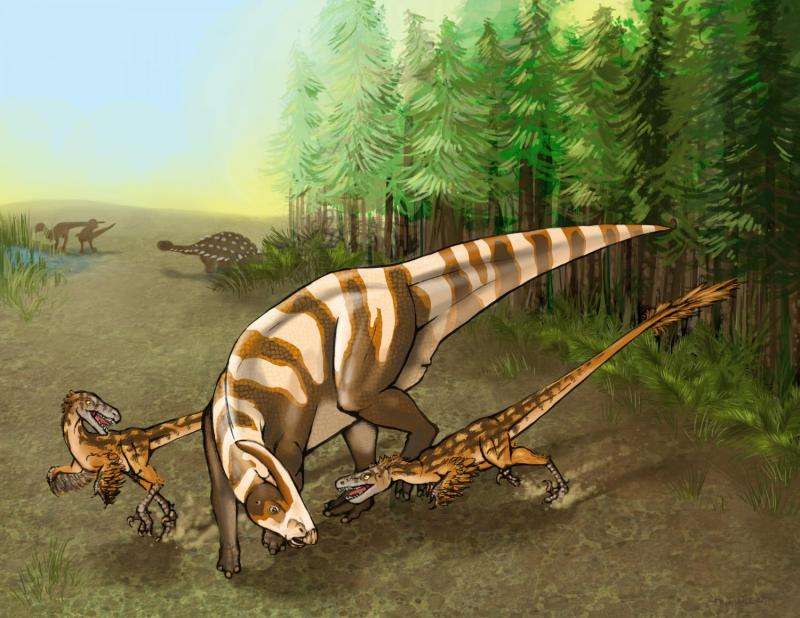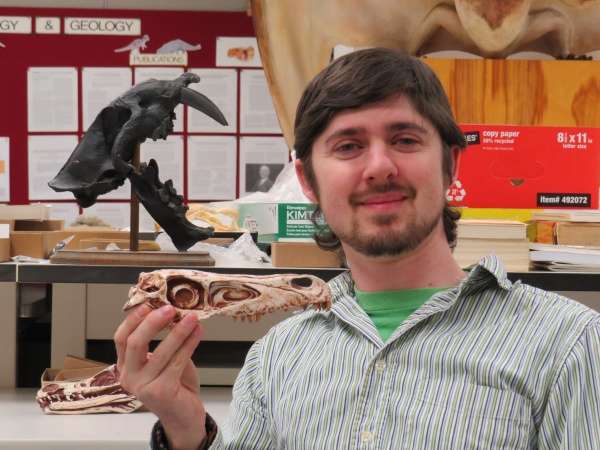New dinosaur's keen nose made it a formidable predator, study finds

A researcher from the University of Pennsylvania has identified a species of dinosaur closely related to Velociraptor, the group of creatures made infamous by the movie "Jurassic Park." The newly named species likely possessed a keen sense of smell that would have made it a formidable predator.
Steven Jasinski, a doctoral student in the School of Arts & Sciences' Department of Earth and Environmental Science at Penn and acting curator of paleontology and geology at the State Museum of Pennsylvania, discovered the new species while investigating a specimen originally assigned to a previously known species. His analysis suggests the fossil—part of the dinosaur's skull—actually represents a brand new species, which Jasinski has named Saurornitholestes sullivani.
Jasinski reported his findings this month in the New Mexico Museum of Natural History and Science Bulletin.
The specimen, roughly 75 million years old, was discovered by paleontologist Robert Sullivan in the Bisti/De-Na-Zin Wilderness Area of New Mexico in 1999. When first described, scientists believed it was a member of Saurornitholestes langstoni, a species of theropod dinosaurs in the Dromaeosauridae family that had been found in present-day Alberta, Canada.
But when Jasinski began a comparative analysis of the specimen to other S. langstoni specimens, he found subtle differences. Notably, he observed that the surface of the skull corresponding with the brain's olfactory bulb was unusually large. This finding implies a powerful sense of smell.

"This feature means that Saurornitholestes sullivani had a relatively better sense of smell than other dromaeosaurid dinosaurs, including Velociraptor, Dromaeosaurus, and Bambiraptor," Jasinski said. "This keen olfaction may have made S. sullivani an intimidating predator as well."
S. sullivani comes from the end of the time of dinosaurs, or the Late Cretaceous, and represents the only named dromaeosaur from this period in North America south of Montana.
At the time S. sullivani lived, North America was split into two continents separated by an inland sea. This dinosaur lived on the western shores in an area called Laramidia.
Numerous dromaeosaurs, which are commonly called raptors, are known from more northern areas in Laramidia, including Alberta and Montana. However, S. sullivani represents the only named dromaeosaur from the Late Cretaceous of southern Laramidia.
S. sullivani shared its world with numerous other dinosaurs. Plant-eating contemporary dinosaurs included the duck-billed hadrosaurs Parasaurolophus walkeri and Kritosaurus navajovius, the horned dinosaur Pentaceratops sternbergii, the pachycephalsaurs Stegoceras novomexicanum and Sphaerotholus goodwini and the ankylosaurs Nodocephalosaurus kirtlandensis and recently named Ziapelta sanjuanensis. Other contemporary meat-eating theropods included the tyrannosaurs Bistahieversor sealeyi and Daspletosaurus, along with ostrich-like ornithomimids.
Though a distinct species, S. sullivani appears to be closely related to S. langstoni. Finding the two as distinct species further shows that differences existed between dinosaurs between the northern and southern parts of North America.
At less than 3 feet at its hip and roughly 6 feet in length, S. sullivani was not a large dinosaur. However, previous findings of related species suggest the animal would have been agile and fast, perhaps hunting in packs and using its acute sense of smell to track down prey.
"Although it was not large, this was not a dinosaur you would want to mess with," Jasinski said
More information: New Mexico Museum of Natural History and Science Bulletin, econtent.unm.edu/cdm/search/collection/bulletins
Provided by University of Pennsylvania




















